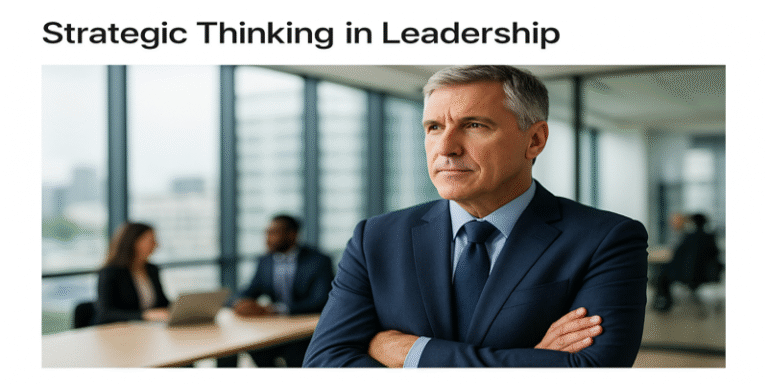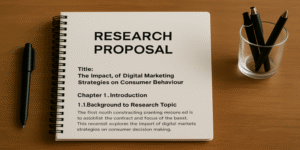Strategic thinking is a cornerstone of effective leadership, enabling leaders to maintain a long-term perspective while addressing immediate organisational challenges. It involves analysing market trends, anticipating threats, and seizing opportunities in an ever-changing environment. As Johnson (2016) notes, strategic thinking is the process through which leaders envision and create a desired future for their organisation. This forward-looking mindset is not only analytical but also creative, involving the integration of insight, foresight, and systems thinking (Mintzberg et al., 2018).
The Concept of Strategic Thinking
According to Liedtka (1998), strategic thinking differs from strategic planning in that it emphasises intuition and synthesis over structured analysis. Strategic thinkers are not just planners; they are visionaries capable of understanding complex environments and aligning actions with long-term goals. Hughes and Beatty (2018) describe strategic thinking as a discipline of seeing the big picture, identifying patterns, and making connections between seemingly unrelated factors. In the leadership context, it requires a balance between rational analysis and creative problem-solving (Goldman & Casey, 2020).
Core Components of Strategic Thinking
Liedtka’s (1998) framework identifies five elements of strategic thinking: a systems perspective, intent-focused orientation, thinking in time, hypothesis-driven reasoning, and intelligent opportunism. These components enable leaders to act both decisively and flexibly in complex environments. Similarly, Mintzberg (1994) suggests that strategic thinking involves synthesis rather than analysis—a process that integrates experience, intuition, and imagination.
A systems perspective allows leaders to see interconnections across the organisation, avoiding siloed decision-making. For example, Bezos’s early leadership at Amazon exemplified systems thinking: his decision to move beyond books into diverse product categories was not reactive but grounded in a comprehensive understanding of digital infrastructure and customer experience. This capacity to anticipate future trends and shape the marketplace rather than react to it is a hallmark of strategic leadership (Mutuma, Ouma & Kanyiri, 2025).
Strategic Thinking and Visionary Leadership
Strategic leaders possess vision—the ability to imagine a desirable future and inspire others to achieve it (Northouse, 2022). Visionary leadership translates strategic thinking into collective purpose. Jeff Bezos’s strategic foresight exemplifies this, as his early commitment to customer-centric innovation positioned Amazon as a leader in e-commerce and cloud computing (Stone, 2013). Similarly, Steve Jobs’s emphasis on design and user experience at Apple reflected a clear strategic vision that integrated creativity, technology, and simplicity.
In contemporary settings, Rosa (2025) highlights how strategic thinking is critical in navigating the AI age, where leaders must integrate technological foresight into decision-making. Leaders must therefore possess both cognitive flexibility and ethical awareness to manage change effectively (Allen, Rorissa & Alemneh, 2025).
Cognitive and Emotional Dimensions
Recent research emphasises that strategic thinking is not purely cognitive but also emotional and social. Goleman (2013) argues that emotional intelligence (EI) enhances strategic thinking by enabling leaders to manage uncertainty, build trust, and maintain resilience. In a study by Virmani (2025), leaders who combined analytical acumen with empathy and adaptability achieved higher organisational performance. This finding aligns with Higgs and Rowland (2011), who propose that the most effective strategic leaders exhibit both strategic intelligence and emotional insight.
Moreover, Bulkan and Higgs (2025) describe how changing organisational landscapes require leaders to adapt to complex, ambiguous environments where emotional intelligence and ethical reasoning become indispensable components of strategy.
Developing Strategic Thinking Skills
Developing strategic thinking requires continuous learning and reflective practice. Educational models such as design thinking have been proposed as tools to enhance strategic leadership capability (Traifeh, Meinel & Friedrichsen, 2025). Design thinking integrates empathy, ideation, and experimentation, promoting innovative problem-solving in leadership contexts (Kayyali, 2026). Training programmes that combine scenario planning, systems analysis, and creative problem-solving can foster strategic thinking skills among emerging leaders (Hughes & Beatty, 2018).
For example, Celik and Keitsch (2025) highlight how social dreaming—a reflective process that links imagination and collective dialogue—can enhance leaders’ capacity for foresight and futures thinking. Similarly, John-Chukwu (2025) shows that product lifecycle thinking in financial decision-making encourages leaders to consider the long-term implications of short-term choices, a critical element of strategic foresight.
Strategic Thinking in Practice: Examples and Case Studies
Amazon’s growth under Jeff Bezos provides a vivid example of strategic thinking in action. Bezos envisioned a digital marketplace that would dominate global retail through customer obsession, technological innovation, and long-term investment (Stone, 2013). His decision to invest in Amazon Web Services (AWS) during the early 2000s, despite short-term losses, demonstrated a deep understanding of emerging digital trends and scalability.
In contrast, Kodak’s decline exemplifies a lack of strategic thinking. Although Kodak invented the first digital camera in 1975, its leadership failed to foresee the disruptive potential of digital photography, clinging instead to its profitable film business (Grant, 2016). This failure to adapt demonstrates the perils of short-term focus and an inability to challenge existing paradigms—issues that strategic thinking aims to mitigate.
A modern illustration can be found in Microsoft’s transformation under Satya Nadella, who repositioned the company toward cloud computing and AI integration. Nadella’s emphasis on a growth mindset and organisational learning fostered a culture of strategic agility (Grant, 2021). This underscores how leaders who cultivate adaptive strategic thinking can guide their organisations through technological and cultural change.
Barriers to Strategic Thinking
Despite its importance, strategic thinking is often hindered by organisational constraints. Rigid hierarchies, short-term performance metrics, and risk aversion can stifle innovative and long-term thinking (Johnson, Scholes & Whittington, 2017). Akhtar, Khan and Khan (2025) found that educational institutions with bureaucratic leadership structures struggled to implement strategic initiatives due to limited autonomy and vision alignment.
Similarly, Dang (2025) notes that geopolitical and cultural barriers can restrict leaders’ strategic capacity in transnational collaborations. Encouraging cross-sectoral partnerships, soft power strategies, and collaborative learning can therefore strengthen global leadership effectiveness.
The Future of Strategic Thinking in Leadership
As the business landscape evolves, strategic thinking will increasingly rely on data analytics, AI-assisted decision-making, and cross-cultural collaboration (Allen et al., 2025). However, human creativity, ethics, and empathy remain irreplaceable. Future leaders must integrate technological acumen with moral responsibility to ensure sustainable organisational development (Jaber, 2025).
Emerging models such as Systemic Design-Oriented Leadership (SDOL) promote holistic thinking by combining design, systems theory, and foresight to navigate complex challenges (Celik & Keitsch, 2025). Such integrative frameworks empower leaders to address the interconnected nature of global issues—from climate change to digital transformation—through adaptive and inclusive strategies.
Strategic thinking is the intellectual and emotional compass that enables leaders to navigate complexity, anticipate change, and inspire collective vision. It transcends mere planning, encompassing systems awareness, creativity, foresight, and empathy. From Bezos’s digital foresight to Nadella’s cultural transformation at Microsoft, successful leaders exemplify how strategic thinking drives innovation and sustainability. As organisations confront new uncertainties—from technological disruption to global crises—leaders who think strategically will be those who not only adapt but also shape the future.
References
Akhtar, T., Khan, W. & Khan, H. (2025) Effectiveness of strategic plan for improving the quality of secondary schools of Khyber Pakhtunkhwa, Pakistan. Pakistan Journal of Social Sciences.
Allen, J., Rorissa, A. & Alemneh, D. (2025) Fostering and cultivating human-AI collaboration and partnerships in an evolving workplace. Proceedings of the Association for Information Science and Technology.
Bulkan, S. & Higgs, M. (2025) The Changing Leadership Landscape. In Dark Leadership: Navigating Toxic Organisations. Springer.
Celik, P. & Keitsch, M.M. (2025) Social Dreaming in Systemic Design-Oriented Leadership (SDOL). International Journal of Design.
Goleman, D. (2013) Focus: The Hidden Driver of Excellence. Harper.
Grant, R.M. (2016) Contemporary Strategy Analysis. 9th ed. Wiley.
Grant, R.M. (2021) Strategic Management: Concepts and Cases. Wiley.
Hughes, R. & Beatty, K. (2018) Becoming a Strategic Leader. Jossey-Bass.
Johnson, G., Scholes, K. & Whittington, R. (2017) Exploring Corporate Strategy. Pearson.
John-Chukwu, P. (2025) Integrating Product Lifecycle Thinking into Financial Decision-Making. ResearchGate.
Kayyali, M. (2026) Redefining Business Education. IGI Global.
Liedtka, J. (1998) Strategic Thinking: Can it be taught? Long Range Planning, 31(1), pp.120–129.
Mintzberg, H. (1994) The Rise and Fall of Strategic Planning. Free Press.
Mutuma, B.G., Ouma, M. & Kanyiri, B. (2025) Skill Evolution in the Age of AI. California International Journal of Management and Administration.
Northouse, P.G. (2022) Leadership: Theory and Practice. 9th ed. Sage.
Rosa, A. (2025) Leadership in the AI Age. Springer.
Stone, B. (2013) The Everything Store: Jeff Bezos and the Age of Amazon. Little, Brown.
Traifeh, H., Meinel, C. & Friedrichsen, M. (2025) Establishing the College of Design Thinking. ResearchGate.
Virmani, N. (2025) Unpacking the Strategic Leadership-Performance Nexus. Journal of IMS Group.
Wheeler, F.E. (2025) Quiet Autism at Work. Routledge.









